Garlic is very popular in our country. It grows well in a variety of climates. When grown, it forms underground bulbs (heads), which consist of individual segments (cloves). In this article we will talk about the rules for growing winter garlic.
Features of planting winter garlic
Autumn planting of garlic is preferable to spring planting, as the heads are larger and denser.For winter cultivation, the largest bulbs are selected, which are split into individual cloves.
If you carefully examine the bulb, then, with the same size, you can notice specimens with thin and thick stems. It is better to select thin-stemmed heads for seeds, which produce more uniform cloves. In thick-stemmed bulbs, the middle segments are too small and unsuitable for planting. These cloves can be used for growing in a two-year culture, then they produce large, even bulbs.
Preparing seed material for planting
Before planting, seed material is thoroughly dried in a warm room. The mesh with teeth is placed on the radiator or placed near the stove and dried for 2-3 weeks. Poorly dried garlic is very susceptible to fungal diseases.
Treating is carried out 1-2 days before planting. The cloves are soaked in a fungicide solution for one hour. Usually they use Fundazol, Thiram, Maxim (the solution is prepared in accordance with the instructions) or in a solution of potassium permanganate of medium concentration. Then the seeds are thoroughly dried. Treating seeds with fungicides prevents the development of fungal diseases of garlic.
Most varieties of winter garlic are suitable for growing in all regions of the country. The most common are:
- Novosibirsk
- Agate
- Reliable
- Onyx
- Anniversary Gribovsky
- Sagittarius
- Losevsky
- Petrovsky
- Union.
Bad and good predecessors
When growing crops, crop rotation must be observed. It cannot be grown in one place for more than one year, as the damage to plants by diseases and pests increases. Garlic can be returned to its original place only after 5 years. Good precursors for culture are:
- melons (zucchini, pumpkin, cucumbers);
- tomatoes;
- cabbage;
- lettuce, dill;
- busy couple
Garlic should not be cultivated after beets, carrots, potatoes, onions and other root vegetables. These crops remove the same substances from the soil as garlic.
When to plant garlic before winter
Before winter, garlic is planted 3 weeks before the onset of the first cold weather. This is usually mid to late October. If you plant it too early, the cloves may sprout and die. If later, they will not have time to take root, some of the cloves will die in the winter, and seedlings in the spring will be rare and weakened.
Possible dates for planting garlic in the fall depend entirely on the weather and vary from year to year. Winter garlic should be planted in sunny places; plants develop worse in partial shade.
Soil preparation
Plants grow well in light to medium loamy soils. The land for winter planting is prepared in advance. Fresh manure or peat cannot be applied, since garlic with such fertilizer goes into the leaf and forms loose heads that are unsuitable for storage. If the soil is very poor, then humus or completely decomposed compost is added several months before planting.
Acidic soils are unsuitable for planting garlic. Seedlings on such soils begin to turn yellow in the spring, the plants develop poorly, the growing season ends earlier, and the heads are small and underdeveloped. To determine acidity, use special devices (sold in stores). They are very simple and easy to use and allow you to determine soil acidity on site.
The soil is acidic if the pH is less than 6.5. To deoxidize it, liming is carried out in the fall: dolomite flour, limestone flour, and fluff are added. Fertilizer is embedded in the ground to a depth of 8-10 cm.
When liming, the speed and duration of action of the fertilizer should be taken into account.
- Dolomite flour. Its effect begins to appear 2 years after application and lasts up to 5 years. When using dolomite flour, the soil will be favorable for planting garlic for the 3rd year.
- Limestone flour. Its effect appears in the 2nd year and lasts 2-3 years. When applied, the soil becomes suitable for garlic in the second year.
- Fluffy. The effect begins immediately after application and lasts 1 year. You can cultivate garlic immediately after adding fluff.
The dose of fertilizer depends on the acidity of the soil.
- On strongly acidic soils (pH below 4.5) the norm is 50-60 kg/acre.
- For medium acidic (pH 4.5-5.5) 30-40 kg/sq.m.
- For slightly acidic (pH 5.5-6.5) 25-30 kg/sq.m.
Lime fertilizers are applied in the fall before digging, evenly distributing them over the surface of the earth.
Since lime promotes the leaching of potassium, potassium fertilizers are added to the soil at the same time. For garlic, potassium sulfate is the best.
Waterlogged soils are unsuitable for growing garlic. Often it does not even sprout because the cloves rot in the damp soil, and the emerging shoots are yellow, stunted, and quickly die.
The beds for winter garlic are dug up in August, incorporating all the necessary fertilizers into the soil. When digging, you can add ash at the rate of a bucket per m2. The earth is leveled and the clods are broken up.
Autumn planting technology
For winter planting, take the largest cloves, from which large, even, dense heads grow. Garlic is planted in cold, dry weather. The place should be well lit all day.
- Furrows are made on the ridges, the distance between which is 23-25 cm.
- If the soil is very dry, then water it and let it air out.
- Plant the cloves in the furrows with the bottom down to a depth of 4-5 cm, slightly pressing them into the ground, at a distance of 15-17 cm from each other.
- Cover the planted cloves with soil.
- Cover the bed with spruce paws or straw. This is done to prevent the garlic from freezing.
If there is not enough space on the site, then you can make a thickened planting. The cloves are planted 9-10 cm apart from each other, and the distance between the rows is reduced to 13-15 cm. With this planting, the heads are somewhat smaller.
Caring for winter garlic
In the spring, spruce branches are removed from the ridges only when the threat of returning cold weather has passed, since garlic seedlings suffer greatly from spring temperature changes.
Top dressing
Young plants are very sensitive to nitrogen deficiency. If there is not enough of it, the leaves begin to turn yellow and the tips dry out. When the first signs of nitrogen starvation appear, root feeding is carried out. It is better to feed with carbamide (urea), since it is less washed out of the soil by precipitation. The solution is prepared at the rate of 3 g per 1 liter of water for one plant. The seedlings on the ridges are watered and then fed.
Watering
Winter garlic does not require much moisture. He gets enough precipitation. It only needs to be watered if the summer is very dry and there is no rain. Excessive moisture leads to damage to plants by fungal diseases, which are extremely difficult to combat, since all pathogens are found in the soil and primarily affect the garlic heads.
If any diseases appear, the affected plants are removed, and the rest are watered with a fungicide solution (Maxim, Hom).
Caring for garlic is simple and involves regularly loosening the soil until the tops cover the row spacing.When loosening the plants, it is necessary to lightly hill up, sprinkling soil on the heads.
Winter garlic can be either bolting or non-shooting. To better form the heads, the arrows are cut off. If it is necessary to grow bulblets, then leave a few arrows and break out the steel ones.
In winter garlic, in mid-July, the leaves above the heads are tied in a knot or pressed down firmly. This technique allows you to extend ripening by 1-2 weeks. While the leaves have not dried, the garlic is pouring in and the longer it remains in the ground during this period, the larger the heads will be.
Harvesting and storing garlic
Garlic is removed from the beds only after the leaves have completely dried. Arrows are a reliable indicator of maturity. When they straighten and the film on the inflorescence bursts, the garlic is ready for harvesting. If you delay, the cloves will begin to sprout. Sprouted garlic is not suitable for storage or planting. It must be used immediately.
In dry weather, the heads are dug up and left on the ridges for several hours. Then they are removed under a canopy, where they are laid out in a thin layer. Garlic is dried for 12-15 days. Then the tops are trimmed, leaving 10-15 cm of the stem, peeled from the integumentary scales, and the roots are trimmed. When storing the harvest, 40 cm of the stem is left in braids so that it can be braided. Store in cold rooms (basements, cellars, sheds) at a temperature of 2-4°C. At higher temperatures, the cloves begin to germinate.
Growing garlic from bulbs
Garlic does not produce seeds. In the summer, it produces arrows in which airy bulbs develop. In breeding they are widely used to develop new varieties. In the garden you can also grow large, dense heads from them.Bulbs should only be obtained from winter garlic, as they are larger and produce good quality heads.
To obtain air bows, several arrows are left. By the end of July, from 60 to 100 bulbs ripen in them, outwardly similar to small cloves. When the arrows straighten and the inflorescence film begins to tear, the arrows are collected and dried.
Bulbs can be planted both before winter and in spring. When planting in autumn, the onions are sown in rows at a distance of 5-6 cm between them to a depth of 3 cm. The ridges must be covered with spruce branches. The next year, care is the same as for regular garlic.
When growing in spring, the bulbs are stratified before planting. They are wrapped in cloth and placed in a cold place (refrigerator, barn), where they are kept for 10-20 days. After this, they are planted as spring garlic. By the end of summer, one-toothed bulbs are formed from the planted bulbs. In autumn they are dug up and dried.
It makes excellent seed material for growing both winter and spring garlic. Single-toothed mushrooms produce very large and dense heads.
The main advantage of winter garlic is its large heads of good quality. But it is unsuitable for long-term storage.
You may be interested in reading other articles about growing garlic:
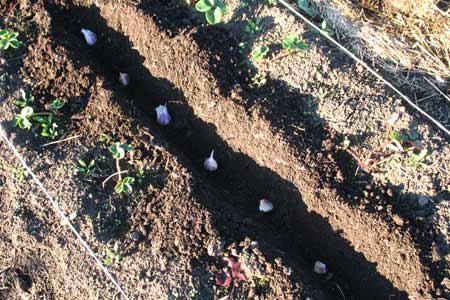
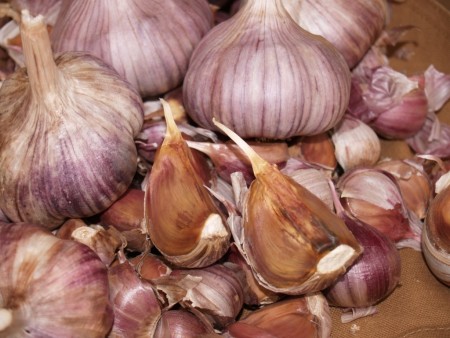
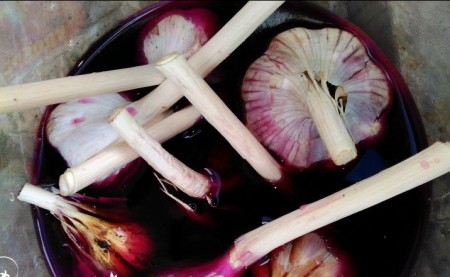
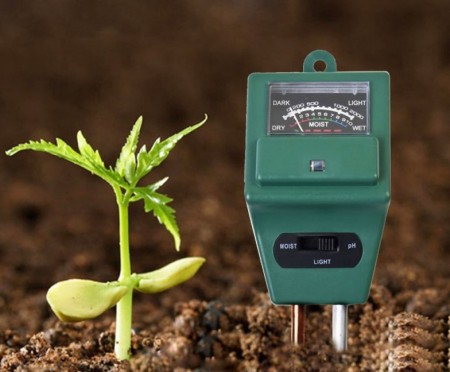
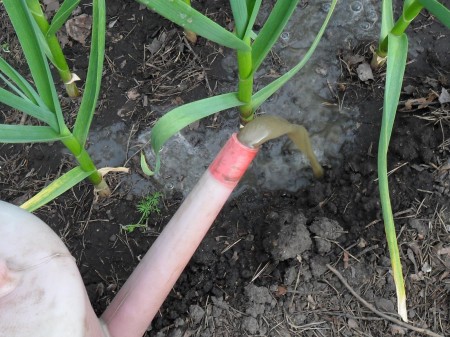
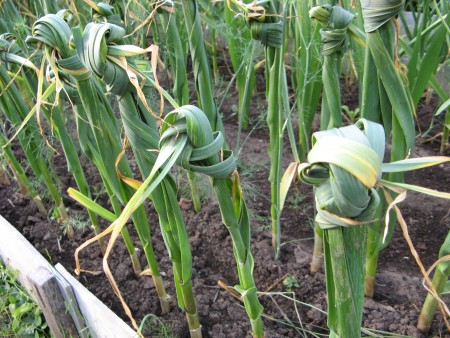
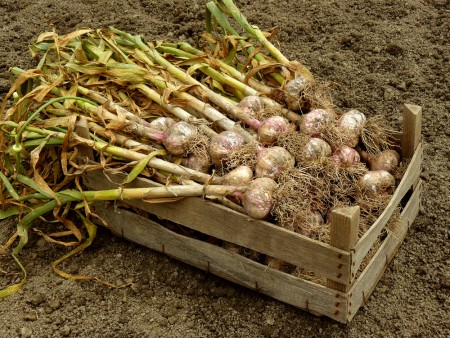
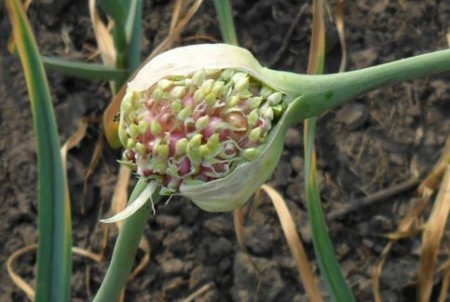

 (24 ratings, average: 4,00 out of 5)
(24 ratings, average: 4,00 out of 5) CUCUMBERS NEVER GET SICK, I'VE BEEN USING ONLY THIS FOR 40 YEARS! I SHARE A SECRET WITH YOU, CUCUMBERS ARE LIKE THE PICTURE!
CUCUMBERS NEVER GET SICK, I'VE BEEN USING ONLY THIS FOR 40 YEARS! I SHARE A SECRET WITH YOU, CUCUMBERS ARE LIKE THE PICTURE! You can dig a bucket of potatoes from each bush. Do you think these are fairy tales? Watch the video
You can dig a bucket of potatoes from each bush. Do you think these are fairy tales? Watch the video
 How our fellow gardeners work in Korea. There is a lot to learn and just fun to watch.
How our fellow gardeners work in Korea. There is a lot to learn and just fun to watch. Eye trainer. The author claims that with daily viewing, vision is restored. They don't charge money for views.
Eye trainer. The author claims that with daily viewing, vision is restored. They don't charge money for views. A 3-ingredient cake recipe in 30 minutes is better than Napoleon. Simple and very tasty.
A 3-ingredient cake recipe in 30 minutes is better than Napoleon. Simple and very tasty. Therapeutic exercises for cervical osteochondrosis. A complete set of exercises.
Therapeutic exercises for cervical osteochondrosis. A complete set of exercises. Which indoor plants match your zodiac sign?
Which indoor plants match your zodiac sign? What about them? Excursion to German dachas.
What about them? Excursion to German dachas.
Thank you! Excellent article, contains all the necessary information.
And thank you very much, Nina, for rating the article. Have a good harvest!